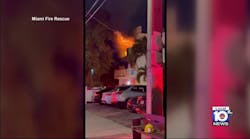The new deputy assistant administrator has been hired and in place for several months, and the new administrator was recently confirmed by the Senate. Yes, the U.S. Fire Administration (USFA) is officially under new leadership.
Glenn Gaines, former fire chief in Fairfax County, VA, is the deputy assistant administrator and Kelvin Cochran, the former fire chief in Shreveport, LA, and Atlanta, GA, is the U.S. fire administrator. Teamed with Dr. Denis Onieal, superintendent of the National Fire Academy, this leadership group (along with the USFA staff) should bring some good things to the fire service. They are very capable people with a lot to do and challenging economic times to do it in.
You can be certain they have already started reviewing existing USFA plans to identify efforts that should be continued, as well as any changes that should be made, and they are no doubt setting their priorities for the coming years. Those priorities may include the following specific national issues that the fire service has been trying to address for years with varying degrees of success:
• The USFA is a critical partner with the National Fallen Firefighters Foundation (NFFF) and the other national fire service organizations in the effort to reduce firefighter injuries and fatalities. Almost five years ago, the fire service embraced 16 Life Safety Initiatives focused on reducing firefighter line-of-duty deaths by 25% in five years (2010) and 50% in 10 years (2015). The first goal (a 25% reduction) has not been met, but there is little doubt that the goals were realistic when established and could still be achieved by 2015.
Continuing to address the 16 Life Safety Initiatives in the long term while in the short term honing in on certain health and wellness issues; vehicle safety and the use of seatbelts; fire officer leadership, supervision and decision-making; command and strategy; crew integrity; and individual responsibility would put the fire service in the best possible position to achieve the goals that were set. To succeed, the training must not only reach the leadership, but it must get to the levels within fire departments where decisions are made and performance actually occurs.
• Fire and life safety public education programs, and fire prevention in general, need more emphasis nationally, and the USFA can be a catalyst for this effort. A lack of public knowledge about safety issues contributes significantly to the quality of fire and life safety. In addition, the fire safety community needs an active federal advocate to help the nation understand and embrace requirements for residential fire sprinklers. A fire sprinkler system, combined with working smoke alarms, provides a very high level of fire safety in homes. USFA is well positioned to join others in being an active (and vocal) advocate for this life-saving technology, and they are also an important partner for other national organizations whose missions focus on prevention and fire and life safety education. As a service, we say that prevention and public education should come first, but we haven't acted that out.
• Emergency medical services (EMS) could become a higher-profile area of responsibility for the USFA. Fire service-based EMS is critical to the pre-hospital 911 emergency care system in our nation. Most fire departments provide some level of EMS, and many provide advanced-level treatment. Even the transport component of EMS is part of many fire department service delivery systems. Throughout the country, especially in the more highly populated areas, as much as 80% of the total call volume of fire departments is EMS related. EMS has been significantly integrated into the fire service and will need advocacy from USFA to be as well supported and effective as possible.
• The stature of USFA within the Federal Emergency Management Agency (FEMA) is critical to its success. The fire service is an important all-hazards player in preparedness, response, mitigation and recovery, and must be viewed, funded and utilized accordingly. Effectively positioning USFA within FEMA is vital to its effectiveness. The nation's fire departments are critical within the National Response Framework (NRF) and the National Incident Management System (NIMS), and the USFA is important to positioning the fire service to be most effective in that role.
At the recent International Association of Fire Chiefs (IAFC) conference, Chief Cochran challenged all of us to "get fully involved" in the fire service within whatever role we fill. He's right, and we should all "get fully involved" in helping the USFA be as successful as possible as this team of leaders, along with their committed and capable staff, do all they can to fulfill their mission. We wish them the very best.
DENNIS COMPTON, a Firehouse® contributing editor, is a well-known speaker and the author of several books, including the When in Doubt, Lead series. He is also co-editor of the current edition of the ICMA textbook Managing Fire and Rescue Services. Compton was the fire chief in Mesa, AZ, for five years and assistant fire chief in Phoenix, AZ, where he served for 27 years. Compton is the past chair of the Executive Board of the International Fire Service Training Association (IFSTA) and past chair of the Congressional Fire Services Institute's National Advisory Committee. He is also chairman of the National Fallen Firefighters Foundation Board of Directors and the chairman of the Home Safety Council Board of Directors.





